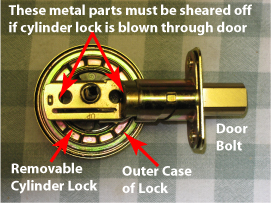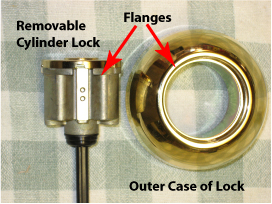Llewelyn Moss (Josh Brolin) is a good ol' Texas boy on an antelope hunt when he discovers the aftermath of a drug deal gone bad. Moss cautiously investigates the scene and finds the gun fight's lone survivor in a bullet riddled pickup begging for agua. "Ain't got no water," Moss curtly replies. What's more, being a humanitarian is not foremost on his mind. His real interest is in finding the money that was to be exchanged for the drugs. After some effort he tracks it down and collects.
The problem is that Moss isnít cold-hearted enough. He can't sleep and so returns with water in the dead of night only to find the subject of his mercy expired. The act of kindness does not go unpunished. Before he can leave, he's chased by gun-shooting hooligans in a 4wd truck. When he tumbles down a bank and escapes into a river, they send a pit bull swimming after him. Nearly exhausted, Moss decides to head for shore and play his trump card: a 45 automatic handgun he had earlier stuck in the back of his waistband. Miraculously, it's still there and even more miraculously, after some fumbling around to get it working, he manages to shoot and kill the dog with a single bullet as it leaps for his throat.
Pit bulls are generally not used by the police because when released to attack, even though trained to subdue perpetrators by clamping down on their arms, they will, likely as not, leap several feet off the ground (pretty much as depicted in the movie) and attempt to lock their jaws on the perpetrator's throat. An attacking pit bull is fearless, relentless, and nearly impervious to pain. It can easily maim or kill a man and nothing less than a fatal shot will stop one.
Okay, there's no law of physics that says a gun can't remain tucked in oneís waistband after running, falling, tumbling down a bank, and swimming in a river. Nor is there a law of physics that says an attacking pit bull can't be stopped at the last instance with a single shot. However, the whole sequence of events is unlikely. In a conflict between a well trained guard dog and a handgun wielding human the guard dog usually wins. Why? The fatal target on a guard dog is small and the dog can cover 50 ft (15.2 m) in about a second. It's difficult to hit something that small moving that fast.
Of course, with $2,000,000 of drug money missing someone associated with the criminal endeavor must track Moss down. The task falls to Anton Chigurh (Javier Bardem), quite possibly the best bad guy since Darth Vadoróa definite plus for the movie. It is, after all, the bad guys not the good guys that give a movie zest.
| Opening Doors
Chigurh drags around an air tank with a cattle euthanizing device called a captive bolt pistol--a symbol of his philosophy. These instruments are used by slaughterhouses to help humanely euthanize cattle before processing them into meat. The device is held against the steer's skull and triggered, propelling a pointed bolt into the steer's brain resulting in an immediate and irreversible loss of consciousness. The bolt then retracts back into the pistol. Although the brain damage is considerable, the captured bolt pistol is carefully designed not to immediately kill the animal. Typically, the animal's brain stem is not destroyed so that its heart will continue beating long enough to drain the animal's blood--a step required to prevent meat spoilage. To Chigurh the world is a giant clockwork mechanism whose output is irreversibly shaped by often random decisions made in brief moments of free will. He is almost Shakespearian in his approach to living, but with a few modifications. Instead of "all the world's a stage", it's all the world's a slaughterhouse with its inhabitants like so many cattle, oblivious to their fate. Chigurh sees himself as simply a tool that completes, not determines oneís destiny. He does not so much kill his victims as euthanize them. In the movie, the captive bolt pistol also comes in handy for opening doors. Held against the cylinder lock and fired, it sends the lock shooting bullet-like out the opposite side of the door. The problem is that when turned by its key, a cylinder locks pushes a bolt into the door frame. To do so the cylinder has to be connected to the bolt. This metal connection blocks the cylinder from being forced through the door (see photographs at right). While the metal in the connection is not as stout as the bolt, it would still take a considerable force to shear through it. A cylinder lock generally also has a metal flange that prevents it from being pushed through the door. A captive bolt pistol is powered by 80 to 120 psi delivering only about 200 pounds of force. However Newtonís 3rd law says that when the bolt pushes on the lock, the lock will push back with an equal and opposite force. Hence, the actual force will only be 200 lbs if the person holding the captive bolt pistol can provide 200 lbs of resistanceónot a likely event. Shearing through the various lock parts would probably require several thousand pounds of force. The captive bolt only moves at velocity of 55 to 70 m/sófaster than a 95 mph (42.5 m/s) fastball but nowhere near the speed of a bullet. So from an impact energy standpoint, the captive bolt is not especially noteworthy. At least two of the blown out locks In the movie are dead bolt types similar to the lock shown in the three pictures at right. These are generally located above the door knob. Even if the blow delivered by a captive bolt pistol were sufficient to force the cylinder lock through the door, the dead bolt would still be in the locked position. Whatís more, the remains of the sheared off connection piece would likely be deformed and jammed, making it nearly impossible to extract the doorís bolt from its locked position and open the door. Locks installed in the middle of door knobs are usually not as robust as dead bolts. Still, even they could not be punched out without shear through internal metal parts. Like the dead bolt this would take a considerable force. If one were punched out it would almost certainly jam the doorknob mechanism in a way that kept the door from opening. Could a captive bolt pistol ever open doors? The short answer: no. By contrast to the captive bolt pistol, a 12 gauge shotgun load is pushed out of the barrel by several thousand psi and reaches an exit velocity of around 370 m/s or over 5 times faster than the highest captive bolt velocity. Keep in mind that when calculating kinetic energy of the projectile, velocity is squared. If the shotgun load had the same mass as the captured bolt, the shotgun load would have over 25 times as much kinetic energy. This explains why the US military uses a specially designed 12 gauge round for blasting open doors. Although a standard 12 gauge round could blow open a door, the door breaching rounds are a lot less likely to penetrate through the door and injure or kill an innocent person on the other side. |
|
So, why is 12 gauge door-breaching relevant to the movie? Chigurh carries a 12 gauge shotgun with a silencer on it, in addition to the air tank and captive bolt pistol. Even if it did work, why tote around an annoyingly clumsy pneumatic device when the shotgun alone could do a Jim Dandy job of euthanizing victims as well as opening doors? Ok, so the door breaching round didnít exist in the 80s when the movie takes place, but so what. Itís not like Chigurh would have cared if he killed someone on the other side and if the first 12 gauge round failed to open the door; he could have followed it up with others.
By the way, the velocity of sound in air is about 340 m/s which means that a typical 12 gauge load will travel through the air fast enough to create a sonic boom almost as loud as the muzzle blast from the gunpowder. To make his silencer work properly, Chigurh would have need to use hand loaded shotgun shells with a reduced amount of gunpowder, thus lowering the velocity of the shot to subsonic levels, but he's a clever guy so we'll assume he did.
Chigurh eventually tracks down Moss with the aid of a transponder hidden in the money. Here the movie gets high marks because the transponder only works at relatively close range. On the other hand, the transponder might not have worked at all. The money was hidden in an air-conditioning systemís return duct, which conveniently connected to the room behind. Itís doubtful that a low powered transponder could have broadcast effectively though the metal ductwork. The grate on the duct did have louvers but even with completely open slits in it a metal plate can still block a radio signal. It depends partly on the wavelength and polarity of the signal and, unfortunately, we have no data on either for the transponder.
We would add that even in the Ď80s motel rooms typically had individual, not collective, air conditioning systems for a multitude of reasons. Individual units could be better adjusted to meet individual needs or turned off for cost reduction when the room was not occupied. Smokers could be isolated from non-smokers and in the event of a fire, deadly fumes and smoke would not be transmitted from room to room.
Although Chigurh fails to find Moss at the first motel, he successfully tracks him to a second. A gun battle ensues, Chigurh and Moss are both wounded, and Moss again escapes. The next morning, in order to treat his wounds, Chigurh must sneak into a pharmacy and obtain medical supplies, but first he needs a diversion. He opens the gas cap on a parked car and wets a piece of cloth with gasoline. He places a combustible cover over the gas tankís opening with the gasoline soaked rag in front of it and lights the rag on fire. Naturally the gas tank dutifully explodes at exactly the right moment and produces the desired distraction.
About the only way this explosion could happen is if the gas tank were essentially empty except for an explosive mixture of gasoline vapor and air. With even a modest amount of gasoline in the tank, the air/vapor mixture would be too rich to burn.
The movie gives us a stylized, metaphor filled, view of life from a very unusual angle that imbues it with considerable merit as a work of art. As for its physics, we can write off the captive bolt pistol business as one of the metaphors. The device is an effective prop that helps convey the twisted logic of the movieís villain. We can ignore the transmitter. It's part in the story is a wash between good and bad physics. We can rationalize the movies many improbabilities. So, weíre left with the exploding car. It could be worse, but we have to say itís certainly no scene for old physics teachers.
| References:
|


